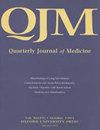Predicting operative mortality after coronary artery bypass surgery in males.
引用次数: 4
Abstract
The general practitioner often requires a simple and reliable method of determining the potential risks of surgical intervention. We derived and tested a simple clinical scoring system for the preoperative prediction of 30-day mortality after coronary artery bypass surgery. From a national register of all open heart operations in the Republic of Ireland 1984-1989, we identified 4276 male patients who had primary isolated non-emergency coronary artery bypass surgery. Using logistic regression, we derived a clinical scoring system to predict operative (30-day) mortality in patients operated on between 1984 and 1987. We then prospectively evaluated the score on patients seen over the next two years. Variables identified for our scoring system were age, recent myocardial infarction, left ventricular failure, extensive distal coronary artery disease and body surface area. Five risk categories were defined; mortality in the high-risk group was 9.7-fold (95% CI: 4.6-20.7) greater than in the low-risk group. When tested on new patients, the relative mortality between the two risk groups was 15.2 (4.6-50.5). The observed and predicted mortalities in each risk group showed close agreement. This clinical scoring system, easily used by a general practitioner, can predict operative mortality in males for whom primary isolated coronary artery bypass surgery is contemplated.预测男性冠状动脉搭桥术后的手术死亡率。
全科医生通常需要一种简单可靠的方法来确定手术干预的潜在风险。我们推导并测试了一个简单的临床评分系统,用于预测冠状动脉搭桥手术后30天死亡率。从1984-1989年爱尔兰共和国所有心脏直视手术的全国登记资料中,我们确定了4276例接受过初级孤立非紧急冠状动脉搭桥手术的男性患者。使用逻辑回归,我们推导了一个临床评分系统来预测1984年至1987年间手术患者的手术(30天)死亡率。然后,我们对接下来两年的患者进行前瞻性评估。我们评分系统的变量包括年龄、最近的心肌梗死、左心室衰竭、广泛的远端冠状动脉疾病和体表面积。定义了五个风险类别;高危组的死亡率是低危组的9.7倍(95% CI: 4.6-20.7)。当对新患者进行测试时,两个危险组之间的相对死亡率为15.2(4.6-50.5)。观察到的死亡率和预测的死亡率在每个危险组显示密切一致。该临床评分系统易于全科医生使用,可以预测考虑进行原发性孤立冠状动脉搭桥手术的男性手术死亡率。
本文章由计算机程序翻译,如有差异,请以英文原文为准。
求助全文
约1分钟内获得全文
求助全文

 求助内容:
求助内容: 应助结果提醒方式:
应助结果提醒方式:


